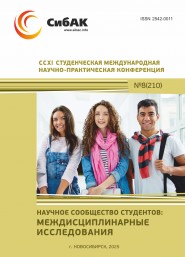Статья опубликована в рамках: CCXI Международной научно-практической конференции «Научное сообщество студентов: МЕЖДИСЦИПЛИНАРНЫЕ ИССЛЕДОВАНИЯ» (Россия, г. Новосибирск, 28 апреля 2025 г.)
Наука: Педагогика
Скачать книгу(-и): Сборник статей конференции
дипломов
THE USE OF INTERNET RESOURCES IN TEACHING FOREIGN LANGUAGES
ABSTRACT
This article explores the integration of internet resources in foreign language education. It highlights the benefits of using modern technologies in classrooms, outlines methods for applying internet-based tools, and analyzes the effectiveness of such approaches in enhancing communicative competence, critical thinking, intercultural awareness, and fostering independent learning.
Keywords: internet resources, foreign language teaching, ICT, online education, digital learning tools.
Introduction
In the modern educational landscape, the integration of internet resources into the process of teaching foreign languages has become not only a useful supplement but a critical component in ensuring effective and engaging learning experiences. Digital technologies open up vast opportunities for enhancing language skills, developing intercultural competence, and providing learners with authentic materials that reflect real-world usage of the target language. The rapid development of information and communication technologies (ICT) has transformed traditional approaches to language learning. Where once learners relied solely on textbooks and classroom communication, today the internet offers a virtually limitless range of possibilities: online language courses, virtual exchanges, multimedia libraries, and global forums are accessible at any time. This shift not only democratizes education but also provides students with greater autonomy in managing their learning processes.
One of the key advantages of internet resources is the ability to simulate an authentic language environment. Students can communicate with native speakers via email, online chats, video conferences, and discussion forums. They can participate in international educational projects, collaborate on research, or simply exchange cultural experiences, all of which enhance their language proficiency in a natural and motivating context.
In addition to improving communicative competence, internet resources contribute to the development of critical thinking and independent research skills. By engaging with real-world content — such as news articles, blogs, scientific journals, and podcasts — learners are encouraged to analyze, compare, and interpret information, which deepens their cognitive engagement with the target language. Moreover, the ability to access materials in different formats (text, audio, video) supports diverse learning styles and ensures a more inclusive learning environment.
Methods of Using Internet Resources in Foreign Language Education
The methods of applying internet resources in teaching foreign languages are diverse and flexible, allowing educators to tailor their approaches to the specific needs and interests of their learners. Effective integration of digital tools not only enriches the educational process but also encourages active learner participation and fosters essential 21st-century skills such as collaboration, problem-solving, and digital literacy.
One powerful method is project-based learning (PBL) conducted through virtual collaboration. In this approach, students from different countries or regions work together on joint projects, using English or another target language as the medium of communication. Such projects may involve environmental issues, cultural studies, or technological innovations, and they require students to communicate, negotiate, and present their ideas effectively.
WebQuests represent another highly effective technique. A WebQuest is an inquiry-oriented activity where students are guided to explore online resources in search of specific information. Teachers design tasks that require critical reading, synthesis of information, and the production of creative outputs.
Virtual discussions and online forums provide a valuable platform for written communication practice. Participating in forums or moderated online discussions allows students to formulate arguments, express opinions, and interact with peers on a wide range of topics.
Multimedia content such as podcasts, video lectures, and interactive exercises keep the learning process dynamic and motivating.
Virtual exchange programs, also known as eTwinning or telecollaboration projects, connect classrooms internationally for authentic communication experiences.
Advantages and Challenges of Using Internet Resources in Foreign Language Education
The integration of internet resources into foreign language education brings undeniable advantages that enrich the learning experience and make it more effective, flexible, and student-centered. However, it also presents certain challenges that educators must address thoughtfully to ensure optimal outcomes. One of the most significant advantages is accessibility. The internet offers learners immediate access to a vast array of authentic materials in the target language. Another important benefit is personalization of learning. Adaptive technologies can automatically adjust the difficulty level of tasks. Internet resources encourage autonomous learning, critical thinking, and independent research skills. However, challenges such as digital literacy gaps, unequal technology access, information overload, and the need to maintain human interaction must be considered. Ethical issues related to privacy, source evaluation, and respectful communication must also be addressed.
Conclusion
The use of internet resources in foreign language education represents a powerful and necessary evolution in contemporary teaching practices. Internet technologies provide learners with unparalleled access to authentic materials, real-world communication opportunities, and personalized learning experiences. Nevertheless, successful integration requires thoughtful planning, addressing challenges like digital divides, and maintaining a balance between technology and human interaction. By embracing digital innovation with wisdom and care, educators can create language learning environments that are effective, inclusive, and connected to the real world.
References:
- Teeler, D., & Gray, P. (2000). How to Use the Internet in ELT. London: Longman.
- Warschauer, M., & Healey, D. (1998). Computers and language learning: An overview. Language Teaching, 31(2), 57–71.
- Johnson, L. (1997). Internet Options in the Classroom. The Internet TESL Journal.
- Crystal, D. (2001). Language and the Internet. Cambridge University Press.
- CyberLeninka.ru – Articles on the use of digital technologies in foreign language education.
- BBC Learning English. Retrieved from https://www.bbc.co.uk/learningenglish
- Duolingo. Retrieved from https://www.duolingo.com
дипломов


Оставить комментарий